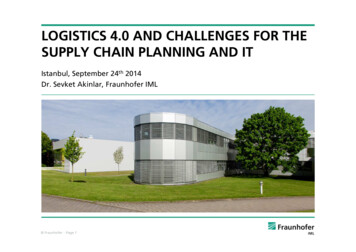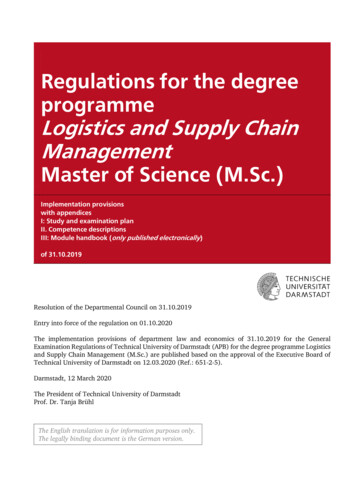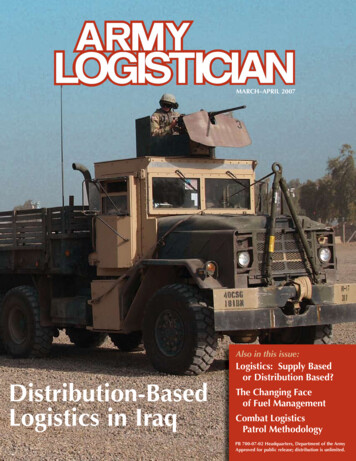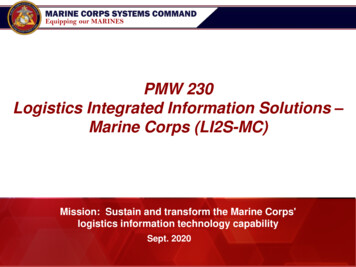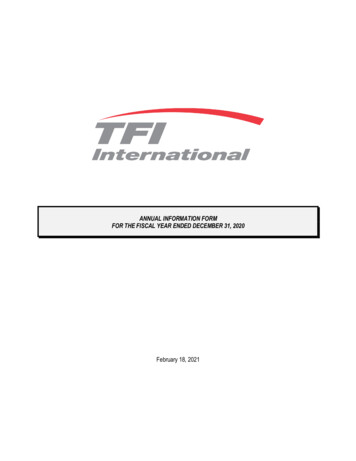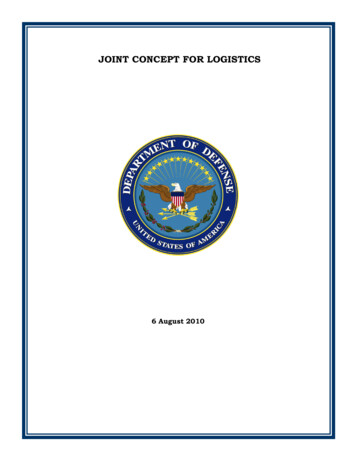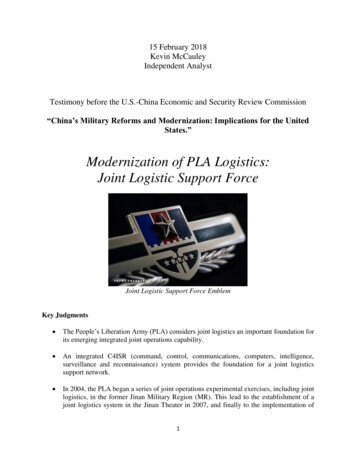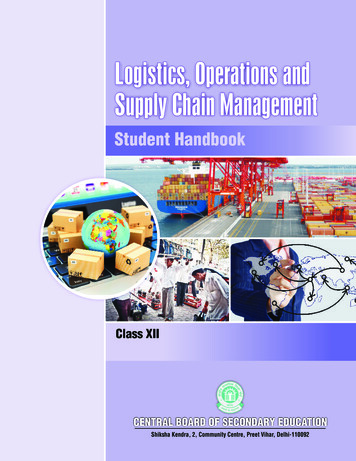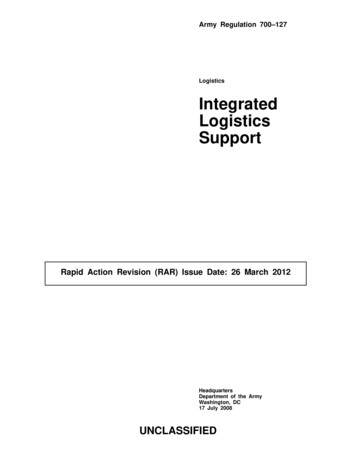
Transcription
Army Regulation 700–127LogisticsIntegratedLogisticsSupportRapid Action Revision (RAR) Issue Date: 26 March 2012HeadquartersDepartment of the ArmyWashington, DC17 July 2008UNCLASSIFIED
SUMMARY of CHANGEAR 700–127Integrated Logistics SupportThis rapid action revision, dated 26 March 2012-oImplements the outcome of the 2009 analysis of alternatives logistics policystudy (paras 2-12 and 3-4).oIncorporates the roles and responsibilities of the product support manager asdefined in the FY10 National Defense Authorization Act, Section 805 (paras 212, 2-13, and 5-7).oImplements policies from DODI 5000.67 (paras 2-12, 2-13, 5-22, and table 31).oImplements policies from DODI 4151.22 (paras 2-12, 5-13, and 5-14).oUpdates responsibilities for the Army Integrated Logistics Support ExecutiveCommittee (para 2-19).oIncorporates the latest updates to DODD 5000.01 and DODI 5000.02, includingthe incorporation of the life cycle sustainment plan (para 5-1).oUpdates condition based maintenance plus definition (para 5-14).oUpdates the logistics demonstrations policy extensively (para 5-16).oMakes additional rapid action revision changes (title page: updatedapplicability statement and updated Army internal control process statement;updated figure 3-1; capitalized Warfighter throughout; changedsupportability strategy to life cycle sustainment plan throughout; changedcombat developer to capability developer throughout; changed integratedlogistic support to integrated logistics support throughout).oMakes administrative changes (app A: modified numbers to DODD 5000.01 andDODI 5000.02; corrected title to AR 11-2; added AR 700-18, DODI 4151.22, DODI5000.67, PL 105-270, 31 USC 501; removed -R from DA Form 11-2 and updated titlein referenced forms; added DA Form 5666 and DA Form 5680 in referenced forms;glossary: deleted unused acronyms and corrected abbreviations as prescribedby Army Records Management and Declassification Agency).
*Army Regulation 700–127HeadquartersDepartment of the ArmyWashington, DC17 July 2008Effective 17 August 2008LogisticsIntegrated Logistics Supportthe United States, and the U.S. Army Reserve. This regulation is applicable duringfull mobilization unless otherwise stated.History. This publication is a rapid actionrevision (RAR). This RAR is effective 26April 2012. The portions affected by thisRAR are listed in the summary of change.Summary. This regulation covers theDepartment of the Army policy for integrated logistics support which includesplanning, developing, acquiring, and sustaining well-defined, affordable supportstrategies for Army materiel. This policyimplements key provisions of DODD5000.01, DODI 4151.22, DODI 5000.02,and DODI 5000.67.Applicability. This regulation applies tothe active Army, the Army NationalGuard/Army National Guard of the UnitedStates, and the U.S. Army Reserve, unlessotherwise stated. Also, it applies to materiel developers, capability developers, andorganizations involved in materiel acquisition within the active Army, the ArmyNational Guard/Army National Guard ofProponent and exception authority.The proponent of this regulation is theAssistant Secretary of the Army for Acquisition, Logistics and Technology. Theproponent has the authority to approve exceptions or waivers to this regulation thatare consistent with controlling law andregulations. The proponent may delegatethis approval authority, in writing, to adivision chief within the proponentagency or its direct reporting unit or fieldoperating agency, in the grade of colonelor the civilian equivalent. Activities mayrequest a waiver to this regulation by providing justification that includes a fullanalysis of the expected benefits and mustinclude formal review by the activity’ssenior legal officer. All waiver requestswill be endorsed by the commander orsenior leader of the requesting activityand forwarded through higher headquarters to the policy proponent. Refer to AR25–30 for specific guidance.Army management control process.This regulation contains internal controlprovisions in accordance with AR 11–2and identifies key internal controls thatmust be evaluated (see appendix C).Supplementation. Supplementation ofthis regulation and establishment of command and local forms are prohibited without prior approval from the DeputyAssistant Secretary of the Army for Acquisition Policy and Logistics(SAAL–ZL), 103 Army Pentagon, Washington, DC 20310–0103.Suggested improvements. Users areinvited to send comments and suggestedimprovements on DA Form 2028 (Recommended Changes to Publication and BlankForms) directly to the Deputy AssistantSecretary of the Army (Acquisition, Policy and Logistics) (SAAL–ZL), 103 ArmyPentagon, Washington, DC 20310–0103.Committee Continuance Approval.AR 15–1 requires the proponent to justifyestablishing/continuing committee(s), coordinate draft publications, and coordinatechanges in committee status with the U.S.Army Resources and Programs Agency,Department of the Army Committee Management Office (AARP–ZA), 9301Chapek Road, Building 1458, Fort Belvoir, VA 22060–5527. Further, if it is determined that an established “group”identified within this regulation, latertakes on the characteristics of a committee, as found in the AR 15–1, then theproponent will follow all AR 15-1 requirements for establishing and continuingthe group as a committee.Distribution. This publication is available in electronic media only and is intended for command levels C, D, and Efor the active Army, the Army NationalGuard/Army National Guard of the UnitedStates, and the U.S. Army Reserve.*This regulation supersedes AR 700–127, dated 27 September 2007. This edition publishes a rapid action revision of AR 700–127.AR 700–127 17 July 2008/RAR 26 March 2012UNCLASSIFIEDi
Contents(Listed by paragraph and page number)Chapter 1General, page 1Purpose 1–1, page 1References 1–2, page 1Explanation of abbreviations and terms 1–3, page 1Responsibilities 1–4, page 1Chapter 2Responsibilities, page 1Assistant Secretary of the Army (Financial Management and Comptroller) 2–1, page 1Assistant Secretary of the Army (Acquisition, Logistics and Technology) 2–2, page 1Deputy Assistant Secretary of the Army (Acquisition Policy and Logistics) 2–3, page 1Assistant Secretary of the Army (Installations, Energy and Environment) 2–4, page 2Assistant Chief of Staff for Installation Management 2–5, page 2Deputy Chief of Staff, G–3/5/7 2–6, page 3Deputy Chief of Staff, G–4 2–7, page 3Deputy Chief of Staff, G–1 2–8, page 3The Chief Information Officer, G–6 2–9, page 3Surgeon General 2–10, page 3Chief of Engineers 2–11, page 4Program executive officer and program managers 2–12, page 4Materiel commands 2–13, page 7Capability developers 2–14, page 8Commander, Army Test and Evaluation Command 2–15, page 9Director, Surface Deployment and Distribution Command–Transportation Engineering Agency 2–16, page 9Trainer/training developers 2–17, page 10Commanders, Army commands, Army National Guard, U.S. Army Reserve, Army service component commands, anddirect reporting units 2–18, page 10Army Integrated Logistics Support Executive Committee 2–19, page 10Other participants 2–20, page 11Chapter 3Process and Framework, page 11Purpose 3–1, page 11Process 3–2, page 11Framework (ten integrated logistics support elements) 3–3, page 12Integrated logistics support process in the acquisition strategy 3–4, page 14Chapter 4Performance-Based Logistics Policies and Implementation, page 15Overview 4–1, page 15General policy 4–2, page 16Integrate requirements and support 4–3, page 19Form performance based logistics team 4–4, page 19Establish performance based agreements and policy 4–5, page 21Award contract — contracting policy 4–6, page 23Army working capital fund secondary items 4–7, page 23Baseline the system — management analysis policy 4–8, page 24Develop performance outcomes – metrics policy 4–9, page 24Select product support integrator(s) 4–10, page 25Develop workload allocation and core logistics – core depot policy 4–11, page 25Develop supply chain management strategies: end-to-end performance based agreements — supply chain managementend-to-end performance based agreement policy 4–12, page 26iiAR 700–127 17 July 2008
Contents—ContinuedDevelop business case analysis–business case analysis policy 4–13, page 27Implementation and assessment — performance based logistics reporting requirement policy 4–14, page 30Chapter 5Supportability, Integrated Logistic Support Management, Maintenance Planning, and OtherConsiderations, page 30Section ISupportability Planning, page 30Life cycle sustainment plan (formerly supportability strategy) 5–1, page 30Supportability analysis and logistics management information 5–2, page 31Integrated logistics support planning considerations 5–3, page 32Resourcing 5–4, page 32Supportability test and evaluation 5–5, page 33Supportability testing restrictions 5–6, page 33Section IIIntegrated Logistics Support Management Structure, page 33Product support manager 5–7, page 33Integrated logistics support manager 5–8, page 33Supportability integrated product team 5–9, page 34Section IIIMaintenance Planning, page 35Maintenance support planning 5–10, page 35Level of repair analysis 5–11, page 35Maintenance task design parameters—system engineering process 5–12, page 35Reliability centered maintenance 5–13, page 36Condition-based maintenance plus 5–14, page 36System support package 5–15, page 36Logistics demonstration 5–16, page 36Core logistics analysis 5–17, page 38Depot maintenance planning and source of repair determination 5–18, page 38Section IVSupportability Considerations, page 42Force development documentation 5–19, page 42Commercial and nondevelopmental items 5–20, page 42Manpower and personnel integration with integrated logistics support 5–21, page 43Environmental impact 5–22, page 43Software 5–23, page 43Post production support planning 5–24, page 44Integrated logistics support after fielding (continuous evaluation) 5–25, page 44System survivability 5–26, page 44Materiel release and materiel fielding 5–27, page 44Advanced technology demonstrations 5–28, page 45Sustainment readiness review 5–29, page 45Chapter 6Contractor Logistics Support, page 46General 6–1, page 46Application of contractor logistics support 6–2, page 47Planning 6–3, page 47Funding considerations 6–4, page 49Contractor logistics support for tables of distribution and allowances unit training systems 6–5, page 49AR 700–127 17 July 2008iii
Contents—ContinuedContractor constraints 6–6, page 49AppendixesA.References, page 50B.Key Performance Based Logistics Milestones and Decision Points, and Implementation Checklist, page 53C.Internal Evaluation Checklist for the Integrated Logistics Support Program, page 57Table ListTable 3–1: Integrated logistics support elements, page 13Table 4–1: BCA Approval thresholds (type II (formal) BCAs), page 27Figure 5–1:5–2:Integrated logistics support process, page 12PBL implementation model, page 17PBL process decision flowchart, page 18Sample PBL team, page 20Organic PBA outline, page 22Spectrum of PBL strategies, page 26PBL BCA format, page 29Depot source of repair determination process, page 39Statutory relationships, page 41GlossaryivAR 700–127 17 July 2008
Chapter 1General1–1. PurposeThis regulation sets the policy for planning, developing, acquiring and sustaining well-defined, affordable supportstrategies that meet the Warfighter’s requirements for Army materiel throughout its life cycle. The policy—a. Defines a deliberate process that the program manager (PM) uses to develop and integrate the support strategyinto the system engineering process to ensure a design can be supported throughout its life cycle.b. Identifies the framework (ten integrated logistics support (ILS) elements) that will be used to develop the supportstrategy.c. Assigns responsibilities for developing the support strategy.d. Sets the policy for developing support strategies in support of Army materiel.e. Outlines responsibilities for implementing support strategies.f. Implements total life cycle logistics requirements outlined in Department of Defense Directive (DODD) 5000.01and DOD Instruction (DODI) 5000.02.1–2. ReferencesRequired and related publications and prescribed and referenced forms are listed in appendix A.1–3. Explanation of abbreviations and termsAbbreviations and special terms used in this regulation are explained in the glossary.1–4. ResponsibilitiesResponsibilities are listed in chapter 2.Chapter 2Responsibilities2–1. Assistant Secretary of the Army (Financial Management and Comptroller)The ASA (FM&C) will—a. Review program and budget requests supporting life-cycle contractor support (LCCS).b. Integrate weapons systems into working capital funds, as appropriate.c. Verify cost and economic analysis (EA) for Army acquisition category (ACAT) I and II programs in accordancewith Army Regulation (AR) 11–18 and the Army portion of joint/other programs and other cost comparison forcurrency, reasonableness, and completeness for use in the decisionmaking or the planning, programming, budgeting,and execution (PPBE) process.d. Provide concurrence/feedback to Deputy Assistant Secretary of the Army (Acquisition Policy and Logistics)(DASA (APL)) policy concerning economic assessments.2–2. Assistant Secretary of the Army (Acquisition, Logistics and Technology)The ASA (ALT) will—a. Oversee the research, development, testing, and evaluation of the acquisition of materiel systems (including ILSfor these systems) (see AR 70–1).b. Establish policy and oversee the development and execution of program management.c. Oversee the acquisition and life cycle logistics management function.d. Ensure that reliability, availability, and maintainability policies are followed during the acquisition process.e. Ensure that logistics considerations are incorporated in the warfighting U.S. Army Training and DoctrineCommand (TRADOC) analysis in coordination with the Deputy Chief of Staff, G–4 (DCS, G–4).f. Approve Type II business case analysis (BCA) for Army Category (ACAT) I/II programs and product supportstrategy packages prepared and submitted by PMs.2–3. Deputy Assistant Secretary of the Army (Acquisition Policy and Logistics)The DASA (APL) will—a. Develop Army ILS policy and provide oversight of ILS PPBE, to include contractor logistics support (CLS) thatsupports the materiel acquisition process.b. Ensure ILS requirements are validated and included in the materiel acquisition process to support full materielrelease of programs and systems.c. Develop policy on performance based logistics (PBL).AR 700–127 17 July 20081
d. Serve as the Army Acquisition Logistician (formerly independent logistician) for new, modified, upgraded, anddisplaced materiel, except for supply class VIII; medical materiel, and strategic communications systems and provide asupportability position on materiel release of ACAT I through III systems. As the Army Acquisition Logistician, theDASA (APL) will—(1) Establish internal procedures and techniques to assess supportability management and execution for all assignedacquisition programs.(2) Assist PMs in defining support plans in terms of requirement, strategy, cost, and affordability.(3) Participate in developing capabilities documents, acquisition strategies/plans, life-cycle sustainment plan (LCSP),test plans, materiel fielding documents, contract and solicitation documents, and other program documentation.(4) Participate in overarching integrated product team (OIPT), PM integrated product team (IPT)/working integratedproduct team (WIPT), supportability integrated product team (SIPT), test and evaluation (T&E) WIPT, and Headquarters, Department of the Army (HQDA) integrated logistics support review (ILSR) activities for all assigned materielsystems.(5) Inform the PM, capability developer (CAPDEV), materiel command, and other program participants of supportability planning deficiencies. Unresolved issues will be elevated to the OIPT.(6) Monitor market surveys and supportability testing.(7) Provide available experience or data to the CAPDEV and PM to influence system design and LCSPdevelopment.(8) Identify and resolve problems and mitigate supportability risks.(9) Participate in milestone decisions and other program reviews.(10) Convene and chair HQDA ILSR for systems approaching a milestone decision review.e. Establish the HQDA position concerning the deployability and supportability of all acquisition programs.f. Establish and manage the Life Cycle Logistics Achievement of the Year awards program to recognize achievements in ILS.g. Monitor the Army ILS and manpower and personnel integration (MANPRINT) effort, in coordination with otherArmy staff agencies, to ensure effective implementation in accordance with HQDA and Department of Defense (DOD)requirements.h. Serve as the HQDA proponent and chairman for the Army Integrated Logistics Support Executive Committee(AILSEC).i. Serve as the HQDA functional chief and representative for the life cycle logistics career field of the ArmyAcquisition Corps/workforce.j. Serve as the HQDA proponent for the system supportability analysis process and the resulting logistics management information (LMI) Program.k. Serve as the HQDA proponent for the DOD acquisition logistics standardization program.l. Chair the DASA (APL) logistics IPTs, as required.m. When a PBL product support strategy is being pursued, staff the BCA with Department of the Army (DA) staffand Headquarters (HQ) Army Materiel Command (AMC) for total Army functional/operational review and DeputyAssistant Secretary of the Army for Cost and Economics (DASA–CE) for EA verification. Once concurrence isreceived from all required parties, the BCA is submitted through the DASA (APL) to the Army acquisition executive(AAE) for approval.n. Assign a primary and alternate Army level PBL Coordinator.o. Perform an enterprise-wide review and analysis of the PBL reports to ensure PBL initiatives are complementaryto each other and in concert with Army acquisition concepts.p. Submit PBL reports and overview briefing(s) to the AAE, and Office of the Secretary of Defense (OSD), asrequired/requested.q. Review security cooperation support plans and projected sales for the Army’s export activities, includingtechnology transfer, direct commercial sales, and foreign military sales.r. Serves as the Army Corrosion Control and Prevention Executive.2–4. Assistant Secretary of the Army (Installations, Energy and Environment)The ASA (IE&E) will—a. Ensure that environmental considerations, including environmental compliance, hazardous materiel use, andenvironmental sustainability, are incorporated into the supportability analyses, in coordination with the DCS, G–4.b. Establish and maintain an organization to manage environmental assessment and supportability of materielsystems, and coordinate with the ASA (ALT).2–5. Assistant Chief of Staff for Installation ManagementThe ACSIM will—a. Coordinate facility construction programs.2AR 700–127 17 July 2008/RAR 29 April 2009
b. Monitor the ILS process for environmental and facility implications.c. Coordinate with the program executive officer (PEO)/PM to perform the necessary analysis, advance planningand programming for receipt of new, modified/upgraded, or displaced systems. Ensure environmental analysis requiredby the National Environmental Policy Act, per Part 651, Title 32, Code of Federal Regulations (32 CFR 651) isaccomplished.d. Program at the gaining installations for new or modified facilities, if any, needed to meet the facility requirementsidentified in the LCSP by the Chief of Engineers (COE).e. Participate in HQDA ILSRs.2–6. Deputy Chief of Staff, G–3/5/7The DCS, G–3/5/7 has responsibility for force development (FD) and establishment of priorities for the employment ofArmy forces and will—a. Ensure the initial production or procurement items of new equipment, including support equipment, are issued tothe training base for timely training development and establishment of functional training documentation andprocedures.b. Ensure unit/activity (modified table of organization and equipment (MTOE))/tables of distribution and allowances(TDA) authorization documents are updated to enable timely requisitioning of personnel, supplies, and equipment.c. Approve Army Warfighter Performance Based Agreements for materiel systems utilizing PBL strategies.d. Participate in HQDA ILSRs.e. Serve as the functional manager for the Army operating and support cost reductions program.2–7. Deputy Chief of Staff, G–4The DCS, G–4 will—a. Evaluate the effectiveness of logistics supportability using readiness reporting and field assessment results.b. Ensure that the sustainment functions of readiness, supply services, maintenance, transportation, aviation, munitions, security assistance and related automated logistics systems management are fully integrated and properlybalanced between acquisition and logistics for the total system life cycle.c. Ensure that logistics data and logistics domain requirements conform to common data standards, specifications,protocols and service oriented architecture to support a Common Logistics Operating Environment (CLOE).d. Participate in HQDA ILSRs.e. Participate in the DASA (APL) logistics IPTs.f. Develop logistics systems that support PM information requirements in coordination with the AMC.g. Issue policy guidance to standardize automatic identification technology (AIT), equipment applications andformats to decrease costs and ensure interoperability.h. Integrate acquisition training into the career development of the logistics workforce in coordination with theDeputy Chief of Staff, G–1 (DCS, G–1).i. Ensure that supply chain principles are considered in the ILS process and supportability analysis.2–8. Deputy Chief of Staff, G–1The DCS, G–1 will—a. Ensure maximum utilization of supportability analysis in meeting MANPRINT objectives.b. Participate in HQDA ILSRs.c. Participate in the DASA (APL) logistics IPTs, as required.d. Establish and disseminate MANPRINT program policies and guidance and ensure adequate integration of ILS andMANPRINT efforts.e. Designate a person to serve on the AILSEC.2–9. The Chief Information Officer, G–6The CIO, G–6 will—a. Review the Army Enterprise Architecture and Army Enterprise Infrastructure to include logistics domain andlogistical data requirements.b. Ensure that logistics data and logistics domain requirements conform to common data standards, specifications,and protocols to support a CLOE.c. Review and support IT investment portfolios for logistics.d. Assist in the preparation of the technical architecture views for integration in the Army integrated logisticsarchitecture (AILA) in support of Joint Capabilities Integration Development System milestone requirements.2–10. Surgeon GeneralThe Surgeon General will—AR 700–127 17 July 2008/RAR 29 April 20093
a. Provide advice and consultation to PMs and CAPDEVs on potential health hazards and problems associated withthe medical aspects of all materiel acquisition programs.b. Develop the ILS program for medical (class VIII) materiel, including designation of the logistician in accordancewith AR 40–60 and AR 40–61.c. Participate in HQDA ILSRs, as appropriate.d. Participate in the DASA (APL) logistics IPTs, as required.e. Designate a person to serve on the AILSEC.2–11. Chief of EngineersThe COE has responsibility for the facilities construction program and land acquisition requirements for the ActiveArmy and will—a. Advise the PM of the facility implications of system design to minimize support facility costs and impact on theArmy’s facilities standardization program.b. Identify facility requirements of the materiel system for the gaining Army commands (ACOMs), Army servicecomponent commands (ASCCs), and direct reporting units (DRUs), with formal input from the PM, trainer/trainingdeveloper (T/TD) and CAPDEV.c. Participate in SIPTs for all facility program requirements and issues.d. Coordinate facility and real property requirements with the CAPDEV, PM, Office of the Assistant Chief of Staff,Installation Management (OACSIM), gaining ACOM, ASCC, and DRUs, Army Acquisition Logistician, and T/TD.e. Assist in preparation of the support facility annex to OACSIM, gaining ACOM, ASCC, and DRUs of selectedsupportability strategies, fielding documentation, and applicable test plans; provide formal coordination and update, asnecessary, on the support facility annex to the supportability strategy; and provide a copy of the support facility annexto ACSIM (DAIM–MD), gaining ACOM, Army National Guard (ARNG), ASCC, United States Army Reserve(USAR), DRUs, and installations.f. Participate in HQDA ILSRs.g. Participate in the DASA (APL) logistics IPTs, as required.h. Designate a person to serve on the AILSEC.2–12. Program executive officer and program managersThe PEOs and PMs are responsible for planning and implementing ILS as an integral part of assigned materielacquisition programs. The PEOs and PMs will enlist the support of the AMC life-cycle management commands(LCMCs) to carry out this responsibility and will—a. Assign a product support manager (PSM) for each major weapon system (or an ILS manager for nonmajorweapon systems) as the focal point for day-to-day oversight and management of the product support functions.b. Establish internal procedures and controls to implement this policy.c. Ensure that passage of a system from one life cycle phase to the next occurs only when all supportabilityrequirements have been satisfactorily accomplished or fully defined in the LCSP. This includes a detailed plan toachieve full materiel release prior to a full-rate production (FRP) decision.d. Prior to pre-milestone B—(1) Designate an ILS manager (ILSM) or PSM to participate in pre-milestone B activities with the CAPDEV.(2) Support the development of the initial LCSP, and lead the update of the LCSP throughout the life cycle.(3) Conduct appropriate supportability analyses with the CAPDEV.(4) Participate in the development of the capabilities documents, and prepare or review all other acquisition programdocumentation to ensure that all logistics support considerations are adequately defined.(5) Serve on SIPTs chaired by the CAPDEV.(6) Prepare, submit, and obtain approval of a Type I BCA that outlines the requirements and functions of thesystem, and determine whether the system should be developed using PBL criteria.(7) Use results from the analysis of alternatives (AoA) in development of the initial LCSP. The AoA is aresponsibility of the DCS, G–3/5/7 (DAMO–CIA) and CAPDEV.e. Designate an ILSM or PSM to lead the SIPT (at milestone B or when the PM is appointed, if earlier, inaccordance with AR 70–1) in the continued refinement and implementation of the LCSP. The ILSM or PSM willestablish or assume the chair of the SIPT at that time. The ILSM or PSM may serve as the MANPRINT manager (seeAR 602–2).f. Pursue a CLOE as part of the overall system acquisition strategy.(1) Integrate a CLOE into new weapon systems procurement and in system acquisitions, modifications, andupgrades based upon a cost benefit analysis.(2) Brief the CLOE strategy as part of each weapon system’s milestone, resource, and readiness review.(3) Address the CLOE strategy in the LCSP.4AR 700–127 17 July 2008/RAR 26 March 2012
g. Ensure that supportability issues and concerns are identified and corrected during testing prior to initial systemfielding, and ensure that deficiencies discovered during and after initial fielding are corrected.h. Ensure that PBL is considered as a support alternative and used if it is determined to be economically andoperationally feasible.(1) When PBL is selected PEOs will—(a) Review, concur, and submit completed Type II BCA to the DASA (APL) Policy for ACAT I and II programs.(b) Review and approve Type I BCA. Provide copy to the DASA (APL) policy directorate.(c) Approve ACAT III BCAs after Army review and concurrence.(d) Appoint a lead PEO/PM for a family of systems or system of systems. The lead PEO/PM and the PEOs/PMs ofsubordinate programs shall collaborate on and review the subordinate BCAs. A macro-level BCA, if necessary, will fallunder the oversight of the lead PEO/PM.(e) Appoint a primary and alternate PBL coordinator.(f) Retain responsibility for actions of PBL coordinators.(2) When PBL is selected, the PM will take the following actions:(a) Identify potential candidates for PBL and proceed with conducting the BCA to determine feasibility of applyingPBL and the alternatives for implementing PBL.(b) Develop and coordinate BCA with the DCS, G–4, AMC LCMCs, TRADOC schools and centers, and theDefense Logistics Agency (DLA).(c) Collaborate with the AMC LCMCs, TRADOC schools, and centers, and DLA to develop potential productsupport strategies.(d) Provide validated cost and economic analyses and other cost comparisons to support the acquisition and PPBEprocesses.(e) Coordinate cost and economic analyses with supporting ACOM cost analysis activities for validation.(f) Complete BCA with TRADOC, AMC LCMC, and DLA collaboration and review, and then forward completedBCA to PEO.(g) Validate and update Type II BCAs prior to the exercise of each contract or performance based agreement (PBA)option period when there are significant changes during contract performance and at completion of contract or PBAperformance.(h) Collaborate with AMC LCMC stakeholders to complete and submit PBL reports.(i) Submit the completed PBL report to designated direct reporting project manager/PEO/LCMC PBL coordinatorfor review and release to higher headquarters.(j) Report system and sub-system/component-level PBL while supporting the LCMC in reporting Army workingc
Commanders, Army commands, Army National Guard, U.S. Army Reserve, Army service component commands, and direct reporting units † 2-18, page 10 Army Integrated Logistics Support Executive Committee † 2-19, page 10 Other participants † 2-20, page 11 Chapter 3 Process and Framework, page 11 Purpose † 3-1, page 11 Process † 3-2 .
